p.533
p.537
p.541
p.545
p.549
p.554
p.558
p.562
p.566
Influence of Protective Layer Thickness on the Mechanical Properties of Reinforced Concrete Beam
Abstract:
In this paper, MFPA (Material Failure Process Analysis) is utilized to simulate the failure process of reinforced concrete member under the situation of four-point bending. The influence which protective layer thickness does on the mechanical properties of reinforced concrete beam is mainly studied. Results indicate that the increase of the protective layer thickness will reduce the sectional effective height of the beam, which decrease the bearing capacity of the member either. Therefore, choosing the protective layer thickness properly will make the member having preferable properties. In this study, what also be found is that generally it is more reasonable when protective layer is within 90 mm. However, it is necessary for the protective layer thickness to be confirmed by relevant specifications and standards on the premise above.
Info:
Periodical:
Pages:
549-553
Citation:
Online since:
December 2010
Authors:
Price:
Сopyright:
© 2011 Trans Tech Publications Ltd. All Rights Reserved
Share:
Citation:


